Fishing Vessel Trip Reports
Greater Atlantic Region Logbook Family of Forms
0648-0212 GARFO Fishing Vessel Trip Report Reporting Instructions - 20191112
Fishing Vessel Trip Reports
OMB: 0648-0212
Greater Atlantic Region
Fishing Vessel Trip Report (VTR)
Reporting Instructions
November 4, 2019
For up to date VTR Instructions and information on eVTR reporting, please vising the Greater Atlantic Regional Office website under Permits & Forms => New England/Mid-Atlantic Vessel Reporting
VESSEL TRIP REPORTING (VTR) OVERVIEW
If you have any questions regarding these instructions, please don’t hesitate to contact the VTR support team at (978) 281-9246. This line is heavily used, so if you get voicemail, please leave your name and number—in most cases, we are able to return calls within one business day.
VTR Requirements by Vessel Permit Type
Permit Type |
Frequency of Reporting |
Reporting Deadline |
If a vessel is issued a Party/Charter permit for: *Summer Flounder; *Scup *Black sea bass *Bluefish *Squid/Atlantic mackerel/Butterfish *Tilefish |
Then the owner/operator must electronically submit trip reports within 48 hours of landing for all Party/Charter trips regardless of species targeted. |
Reports must be electronically submitted using an approved eVTR reporting application within 48 hours of landing.
This requirement applies to all Party/Charter trips regardless of species targeted otherwise use the below guidance. |
If a vessel is issued a permit for: *Atlantic herring; *Atlantic mackerel; *Illex squid; *Longfin squid/butterfish; *Northeast multispecies; *Ocean quahogs: *Surfclams . . . . |
Then the owner/operator must submit trip reports weekly |
Reports must be postmarked or received by midnight of the Tuesday following the reporting week (Sunday through Saturday). If a trip starts in one week, and offloads in the next, it should be reported in the week the catch was offloaded. |
If a vessel is issued a permit for: *Atlantic bluefish *Atlantic deep-sea red crab *Atlantic sea scallop *Black sea bass *Monkfish *Northeast skate *Scup *Spiny dogfish *Summer flounder *Tilefish . . . . |
Then the owner/operator must submit trip reports monthly |
Reports must be postmarked or received within 15 days of the end of the month. If a trip starts in one month, and offloads in the next, it should be reported for the month in which the catch was offloaded
|
If a vessel is issued a permit for American lobster and no other Greater Atlantic Region vessel permit . . . . |
Then the owner/operator is not required to submit trips reports (check with your state, which may require reporting). |
|
Defining fishing trip activity that requires a VTR
If your vessel is issued any of the fishery permits with reporting requirements shown in the table above, you are required to complete a VTR for every fishing trip, whether the vessel is fishing in state or federal waters, or in another region of the country, such as Gulf of Mexico. This is true for all trips, no matter what species is being fished for or caught. Having an observer or at-sea monitor on board during a trip does not relieve you from this requirement.
These instructions clarify that a VTR is required for any trip on a federally permitted vessel when you catch fish, or when your operations include activities that would support fishing, such as preparing to catch or harvest fish, or attempting to catch or harvest fish. All such fishing activities must be reported, even if no landings are made. The trip is the period of time during which these activities are conducted, beginning when the vessel leaves port and ending when the vessel returns to port.
You are required to report fishing trips even if no fish are caught or onboard if the following events occur:
If you begin a fishing trip, but must return to port before setting or retrieving gear because of issues like bad weather or mechanical problems, then you must still complete a VTR. In this case, you must complete the information in VTR Fields 1-6, along with fields 24-27, and enter “No Effort” in the lower portion of the VTR.
If you make a fishing trip just to set out gear you must still complete a VTR. Complete the information in VTR fields 1-6, along with fields 24-27, and enter “Set Only” in the lower portion of the VTR.
If you make an unsuccessful trip, and don’t catch any fish, you must still complete a VTR. In this case, you must complete all of the trip information in VTR Fields 1-16, and enter “No Catch” or “NC” in the species code field (#17).
There are several instances where a VTR isn’t required for a specific trip:
If you are transiting without any product onboard and don’t engage in any fishing activity. For example, you’re moving your vessel to a shipyard or you’re returning to your home port.
If you are operating under a scientific Letter of Acknowledgement
If you are operating as a Herring Carrier Vessel
When to complete and submit more than one VTR page
You must complete all of the fields on a new VTR page each time you change your fishing area or gear. This means a new page is required each time you:
Change the chart area (inshore or offshore) in which you are fishing;
Change the type of gear you are using; or
Change the mesh size or ring size in the gear you are using.
New gear codes
VTR Field #7 requires you to identify the type of gear you used. New codes have been added to the gear code table (page 7) so that we can get better information about fishing gears. The scallop dredge codes are critical for evaluating the effectiveness of scallop dredge gear modifications for reducing interactions with sea turtles. The codes are summarized below:
DRS – this code should be used for the standard scallop dredge
DSC – this code should be used for the standard scallop dredge with chain mat
DTS – this new code should be used for the scallop turtle deflector dredge
DTC – this new code should be used for the scallop turtle deflector dredge with chain mat
OTT – this code should be used for otter trawls (OTF) that are joined together in a “Twin Trawl” configuration. A “Twin Trawl” refers to two nets that are joined together in the middle as shown in below (Figure 1).
TTS – this code should be used for otter trawls, shrimp (OTS) that are joined together in a “Twin Trawl” configuration. A “Twin Trawl” refers to two nets that are joined together in the middle as shown in below (Figure 1).
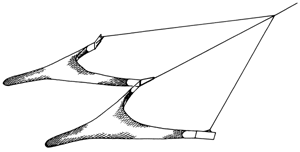
How to report when you fish in more than one chart area
If your fishing activity occurs in more than one chart area, you must submit a VTR for each chart area where you started to haul back or retrieve gear. If your tow or the placement of your fixed gear (for example, gillnets) crosses chart area boundaries, the area you report must be the area you were in when you started to retrieve or haul back your gear. For the gear types shown in the gear code table on page 9, this means:
For mobile gear (trawl gears and dredges), you report the area where the hauling equipment is put into gear with the intention of hauling back and retrieving a net or dredge.
For fixed gear (gillnets, longline, pots, traps, and weirs) you report the area where the hauling equipment is put into gear or retrieval of one end of the set begins.
For purse seine gear, and other seine gears, you report the area where the skiff hits the water upon setting the gear, or when the first piece of gear hits the water, whichever occurs first.
For handline, rod and reel, and the gears listed as “other gears”, you report the area where the gear is completely retrieved and aboard the vessel.
For example, if you start a tow in chart area 522, start hauling back in area 525, and land 100 pounds of monkfish, then all the catch from this tow would be reported in chart area 525.
Protected Species
You must report all species caught (both kept and discarded), including all protected species. To report sea turtles or ESA-listed fish species (e.g., Atlantic salmon or sturgeon) incidentally caught, injured, or killed, enter the species code for each turtle or fish under the species code name column (#17) on the VTR. Enter the actual number (count) of sea turtles or listed fish caught in the discard column (#19). Under the dealer name column (#21), comment on the condition of the sea turtles or listed fish (e.g., alive, injured, or dead).
When an incidental mortality or injury of a marine mammal (seals, dolphins, porpoises, and whales) occurs during commercial fishing activities, you must also fill out and return the Marine Mammal Authorization Program Mortality & Injury Reporting Form within 48 hours of returning from the trip on which the incident occurred. You may obtain additional information, including a reporting form, by visiting the Greater Atlantic Region's website or calling (978) 281-9328.
The National Marine Fisheries Service requires vessel trip information for the conservation and management of marine fishery resources in accordance with the Magnuson-Stevens Fishery Conservation and Management Act. The data reported will be used to develop, implement, and monitor fishery management strategies and for a variety of other uses. Submission is mandatory for those persons falling under the requirements of 50 CFR 648.7 (b). All data submitted will be handled as Confidential material in accordance with NOAA Administrative Orders. Public reporting burden for the survey is estimated to average 5 minutes per response, including the time for reviewing instructions, searching existing data sources, gathering and maintaining the data needed, and completing and reviewing the collection of information. Send comments regarding this burden estimate or any other aspect of this collection of information, including suggestions for reducing this burden, to NOAA Fisheries, 55 Great Republic Drive, Gloucester, MA 01930.
Notwithstanding any other provision of the law, no person is required to respond to, nor shall any person be subject to a penalty for failure to comply with, a collection of information subject to the requirements of the Paperwork Reduction Act, unless that collection of information displays a currently valid OMB Control Number.
Privacy Act Statement
Authority:
The collection of this information is authorized under the
Magnuson-Stevens Fishery Conservation and Management Act, 16 U.S.C
1801 et seq..
Purpose: The Magnuson-Stevens Act
requires that conservation and management measures must prevent over
fishing while achieving, on a continuing basis, the optimum yield
from each fishery. Vessel logbooks are essential tools in the
management of fishery resources. Section 303(a)(5) of the
Magnuson-Stevens Act specifically identifies the kinds of data to be
collected for fishery management plans (FMPs).
Routine
Uses: The Department will use this information for effective
fishery management. Disclosure of this information is permitted under
the Privacy Act of 1974 (5 U.S.C. Section 552a), to be shared within
NMFS offices, in order to coordinate monitoring and management of
sustainability of fisheries and protected resources, as well as with
the applicable State or Regional Marine Fisheries Commissions and
International Organizations. Disclosure of this information is also
subject to all of the published routine uses as identified in the
COMMERCE/NOAA-6,
Fishermen's Statistical Data.
Disclosure:
Submission is mandatory for those persons falling under the
requirements of 50 CFR 648.7 (b). If the information is not
provided, permit status may be affected.
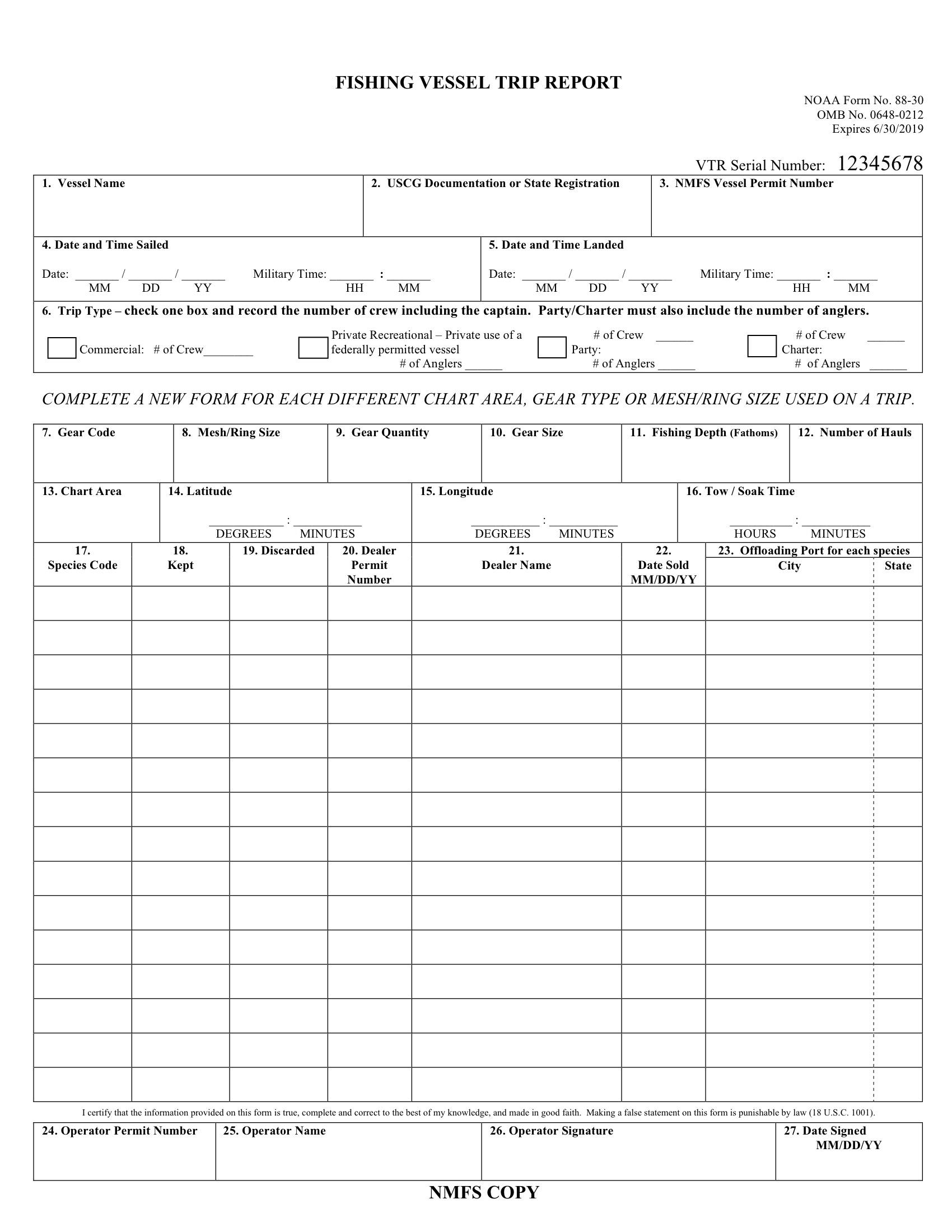
DETAILED INSTRUCTIONS
All fields on the VTR must be completed using blue or black ink only.
Incomplete, incorrect, and illegible VTRs will be returned to the vessel owner for correction.
1. Vessel Name: Enter the name of your vessel. If your vessel does not have a name use UNNAMED.
2. USCG Documentation or State Registration: Enter the official documentation number of your vessel. If your vessel is not documented with the Coast Guard, enter the state registration number of your vessel.
3. NMFS Vessel Permit Number: Enter the six digit number printed on the fishing permit issued to your vessel by NMFS, Greater Atlantic Regional Office, Gloucester, Massachusetts.
4. Date and Time Sailed: Enter the month, day, year and time (using the 24 hour clock/military time) you sailed. For example, January 1, 2010 at 4:15 PM should be recorded as 1/1/10 for date and 16:15 for time.
5. Date and Time Landed: Enter the month, day, year and time (using the 24 hour clock/military time) you arrived in port. For example, January 1, 2010 at 4:15 PM should be recorded as 1/1/10 for date and 16:15 for time.
12 to 24 Hour Time Conversion Table
-
Midnight to Noon Conversion
Noon to Midnight Conversions
12:00 AM = 00:00 (Midnight)
12:00 PM = 12:00 (Noon)
1:00 AM = 01:00
1:00 PM = 13:00
2:00 AM = 02:00
2:00 PM = 14:00
3:00 AM = 03:00
3:00 PM = 15:00
4:00 AM = 04:00
4:00 PM = 16:00
5:00 AM = 05:00
5:00 PM = 17:00
6:00 AM = 06:00
6:00 PM = 18:00
7:00 AM = 07:00
7:00 PM = 19:00
8:00 AM = 08:00
8:00 PM = 20:00
9:00 AM = 09:00
9:00 PM = 21:00
10:00 AM = 10:00
10:00 PM = 22:00
11:00 AM = 11:00
11:00 PM = 23:00
6. Trip Type: Check the box for the appropriate trip type: Commercial, Recreational, Party or Charter.
Note: Only a single trip type box should be checked for any given trip.
# of Crew: Enter the total number of crew members including the captain. If you have an Observer onboard do not include them in the crew count. Party/Charter/Recreational vessels should include all crew members or employees on board for the trip.
# of Anglers: For party/charter/recreational trips only: enter the total number of anglers, excluding the vessel's crew.
7. Gear Code: Enter the three letter code found in the Gear Codes Table (below) of the gear being fished. If more than one gear type was used during this trip, a separate report page must be completed for each gear used. If you are fishing with a gear type not provided in the table below, please contact the Vessel Trip Reporting office at (978) 281-9246 for guidance.
Gear Codes Table
|
|
||||||||||||||||||||||||||||||||||||||||||||||||||||||||||||||||||||||||||||||||||||||||||||||||||||||||||||||||||||||||||
8. Mesh/ Ring Size: Enter mesh/ring size of the gear being fished. Use the definitions in the Fishing Effort Information by Gear Type Table located below. If more than one mesh/ring size was used in a haul (for example, multiple mesh sizes in a string of gillnets), enter the average mesh size per haul. If you changed mesh/ring size during this trip (for example, changing from a large mesh trawl to a small mesh trawl), complete a separate report page for each mesh/ring size used.
9. Gear Quantity: Enter the quantity of gear being fished per haul. Use the definitions in the Fishing Effort Information by Gear Type table located below. If more than one of this gear type was used during the trip, enter the average quantity of gear used per haul.
10. Gear Size: Enter size of the gear being fished using the definitions in the Fishing Effort Information by Gear Type table located below.
11. Fishing Depth: Enter the average depth fished in fathoms.
12. Number of Hauls: Enter the total number of tows, sets, or strings you hauled as appropriate for your gear using the Fishing Effort Information by Gear Type table located below.
13. Chart Area: Enter the three-digit area fished from the charts supplied below. Area fished may be an offshore area (indicated by bold font in the attached charts) or an inshore area (indicated by small font in charts). For each area (inshore or offshore) where the start of haul back occurred during a trip, a separate VTR page for each area must be completed using the three-digit code from the appropriate chart found at the end of this document. For instance, if nine of your tows started and ended in one area you would report this area on your VTR log. If on the tenth tow you crossed into a new area and started hauling back in that area, you would fill out a new VTR log and report the new chart area.
If you’re fishing north of 35 degrees latitude and east of the demarcated area boundaries, enter 899
If you’re south of 35 degrees latitude and east of the demarcated area boundaries, enter 799
If fishing in the areas found on the inshore charts for MA, RI, CT, and NY state waters (Charts 5, 6, and 7), use the inshore code (small font) when appropriate. For example, if you’re fishing just off of the tip of Cape Ann (Chart 5) you would report area 116. Likewise, if you are fishing just off of New Haven in Long Island Sound (Chart 7) you would report area 143.
Catch should be reported based upon the chart area where the start of your haul back occurred.
For mobile gear (trawls and dredges), this is when the hauling equipment is put into gear with the intention of hauling back and retrieval of net/dredge begins.
For fixed gear (gillnets, longline, pots, traps, and weirs), this is when the hauling equipment is put into gear or retrieval of one end of the set begins.
For purse seine gear, and other seines, this is when the skiff hits the water upon setting the gear, or the first piece of gear hits the water, whichever occurs first.
For all other gears (handline, rod and reel, and the gears listed in the Gear Code Table above as “other gears”), you report the area where the gear is completely retrieved and aboard the vessel.
14. Latitude: When multiple haul-backs occur in the same chart area, enter a single geographic position using either latitude (degrees and minutes) or loran of the haul-back position where the majority of your fishing effort occurred.
15. Longitude: When multiple haul-backs occur in the same chart area, enter a single geographic position using either longitude (degrees and minutes) or loran of the haul-back position where the majority of your fishing effort occurred.
The Position to Report by Gear Type Table below defines, by gear type, the position to report for the “majority of fishing effort”.
Position to Report by Gear Type Table
Gear Type |
Position to Report for “Majority of Fishing Effort” |
Trawl |
Location of the start of haul back for the longest tow |
Dredge |
Location of the start of haul back for the longest tow |
Gillnet |
Location of the start of haul back for the string with the most panels |
Pots |
Location of the start of haul back for the string with the most pots |
Seines |
Location of the start of haul back for the longest soak |
Rod & Reel\Hand Line |
Location where the majority of casts occurred; or if drifting, where the first cast of the drift occurred |
Diving |
Location where the last dive ended |
Longline |
Location of the start of haul back for the longest line |
Harpoon |
Location where the majority of casts occurred; or if drifting, where the first cast of the drift occurred |
Cast Net |
Location where the majority of casts occurred; or if drifting, where the first cast of the drift occurred |
Traps |
Location of the start of haul back for the string with the most traps |
Hand Rake |
Location where the majority of raking occurred |
Tow/Soak Time: Depending upon the gear used, you will enter either the average tow time per haul, the total time that the gear soaked or the estimated time you spent fishing (not including travel time). Enter the amount of time fishing (hours and minutes).
Mobile Gear (trawl, dredges, etc.): Enter the average amount of time per tow which is defined as from the time the gear is completely hooked up to when the gear is completely hauled back.
Fixed Gear (gill nets, long lines, pots, etc.): Enter the average time that the gear soaked which is defined as starting when the first piece of gear is deployed and ending when the last piece of gear is hauled back.
Seines: Enter the average soak time per haul
Rod & Reel / Hand Line: Enter the total amount of time the lines were actually fishing.
Harpoon: Enter the total amount of time spent searching for targeted species.
Diving: Enter dive time
The Fishing Effort Information by Gear Type Table below summarizes how mesh/ring size, gear quantity, gear size, number of hauls and tow/soak time should be filled out for different gear types.
Fishing Effort Information by Gear Type Table
Gear Type |
Reporting Field |
Reporting Guidance |
Trawl |
Mesh/Ring Size |
Smallest mesh size used in Cod end or liner |
Gear Quantity |
Number of individual trawls being towed at one time |
|
Gear Size |
Sweep (foot rope) length in feet |
|
Number of Hauls |
Number of tows hauled per trip |
|
Tow/Soak Time |
Average tow time per haul (hours : minutes) |
|
Dredge |
Mesh/Ring Size |
Ring size |
Gear Quantity |
Number of individual dredges being towed at one time |
|
Gear Size |
Dredge width in inches |
|
Number of Hauls |
Number of tows hauled per trip |
|
Tow/Soak Time |
Average tow time per haul (hours : minutes) |
|
Gillnet |
Mesh/Ring Size |
Mesh size |
Gear Quantity |
Average number of nets per string |
|
Gear Size |
Average length of the nets used in a string (not the entire string) |
|
Number of Hauls |
Total number of strings hauled per trip |
|
For example, a string 3000 feet in total length would typically consist of 10 nets (Gear Quantity) with an average length of 300 feet (Gear Size). |
||
Tow/Soak Time |
Average soak time per haul (hours : minutes) |
|
Pots |
Mesh/Ring Size |
Entrance (ring, hoop) size |
Gear Quantity |
Average number of pots per string |
|
Gear Size |
Total number of pots in the water |
|
Number of Hauls |
Total number of strings hauled per trip |
|
Tow/Soak Time |
Average soak time per haul (hours : minutes) |
|
Seines |
Mesh/Ring Size |
Mesh size |
Gear Quantity |
Number of nets |
|
Gear Size |
Length of head rope in feet |
|
Number of Hauls |
Number of seines hauled per trip |
|
Tow/Soak Time |
Average soak time per haul (hours : minutes) |
|
Rod & Reel \ Hand Line |
Mesh/Ring Size |
Leave blank |
Gear Quantity |
Average number of hooks per line |
|
Gear Size |
Leave blank |
|
Number of Hauls |
Leave blank |
|
Tow/Soak Time |
Enter total amount of time the lines were fishing |
|
Fishing Effort Information by Gear Type Table - Continued
Gear Type |
Reporting Field |
Reporting Guidance |
||
Diving |
Mesh/Ring Size |
Leave blank |
||
Gear Quantity |
Leave blank |
|||
Gear Size |
Leave blank |
|||
Number of Hauls |
Leave blank |
|||
Tow/Soak Time |
Dive time (hours : minutes) |
|||
Longline |
Mesh/Ring Size |
Leave blank |
||
Gear Quantity |
Number of hooks per line |
|||
Gear Size |
Main line length to the nearest tenth of a nautical mile e.g. 1.5 |
|||
Number of Hauls |
Number of sets hauled |
|||
Tow/Soak Time |
Average soak time per haul (hours : minutes) |
|||
Harpoon |
Mesh/Ring Size |
Leave blank |
||
Gear Quantity |
Number of harpoons |
|||
Gear Size |
Leave blank |
|||
Number of Hauls |
Number of throws |
|||
Tow/Soak Time |
Total amount of time spent searching for targeted species (hours : minutes) |
|||
Cast Net |
Mesh/Ring Size |
Mesh size |
||
Gear Quantity |
Leave blank |
|||
Gear Size |
Average radius of net(s) |
|||
Number of Hauls |
Number of hauls |
|||
Tow/Soak Time |
Total amount of time spent searching for targeted species (hours : minutes) |
|||
Traps |
Mesh/Ring Size |
Mesh size of crib |
||
Gear Quantity |
Number of traps |
|||
Gear Size |
Length of leader (feet) |
|||
Number of Hauls |
number of sets lifted |
|||
Tow/Soak Time |
Average soak time per haul (hours : minutes) |
|||
Hand Rake |
Mesh/Ring Size |
Leave blank |
||
Gear Quantity |
Leave blank |
|||
Gear Size |
Leave blank |
|||
Number of Hauls |
Leave blank |
|||
Tow/Soak Time |
Total time spent fishing (hours : minutes) |
|||
17. Species Code: Enter the code of each species caught. Use the codes found below in the Species Code Table. If other species were caught that are not provided in the table please call the Vessel Trip Reporting office at (978) 281-9246 for guidance.
18. Kept:
Commercial Trips: Enter the hail weight (in pounds) of each species in the KEPT column. Groundfish catch retained for home consumption should have its fillet weight entered.
Recreational Trips: Enter the count for each species in the KEPT column.
Party & Charter Trips: Enter the count for each species in the KEPT column.
19. Discarded:
Commercial Trips: Enter the hail weight (in pounds) of each species in the DISCARDED column.
Recreational Trips: Enter the count of each species in the DISCARDED column.
Party & Charter Trips: Enter the count of each species in the DISCARDED column.
Note: In the case of lobsters, only those that are dead should be annotated under discards.
20. Dealer Permit Number: Enter the NMFS Greater Atlantic Region permit number issued to each dealer purchasing your catch. If all species for the trip are sold to the same dealer, only enter the dealer number for the first species and draw a line down through the following Dealer Permit Number lines.
If any portion of the catch of a species landed is not sold to a Federally permitted dealer, enter the appropriate code listed in the Dealer Codes Table below.
Dealer Codes Table
-
Code
Definition
1
Seized for Violations
2
Sold to another vessel for bait or retained as bait
4
Retained for future sale
5
Sold to a non-Federal dealer (non-Federally regulated species only)
6
Sub legal catch landed for research
7
Legal catch landed for research (EFP trips only)
8
Landed, unmarketable catch (LUMF)
99998
Used for home consumption
21. Dealer Name: Enter the name of the dealer who purchased each species of your catch for this trip. If all species for the trip are sold to the same dealer, only enter the dealer name for the first species and draw a line down through the following DEALER NAME lines.
22. Date Sold: Enter the month, day and year that each species of your catch for this trip was sold or otherwise disposed of. If all species for the trip are sold on the same date, only enter the date sold for the first species and draw a line down through the following DATE SOLD lines.
23. Offloading Port (Equivalent to Landing Port for Party\Charter vessels): Enter the city and state of the port where each species was physically offloaded, or where the trip ended\landed, as appropriate.
24. Operator Permit Number: Print your NMFS Operator's Permit Number. This is the 8 digit number on the Operator's Permit issued by the NMFS/GARFO Permit Office.
25. Operator Name: Print your name as it appears on your Operator's Permit.
26. Operator Signature: Signature of the vessel operator, Captain or person responsible for the truth and accuracy of the VTR.
27. Date Signed: The date the report was signed in MM/DD/YY format.
Species Codes Table
|
|
Species Codes Table - Continued
|
|
Species Codes Table - Continued
|
|
Frequently Asked Questions
Question: If I change gear type, mesh size, or chart area fished during a trip, how do I complete my VTR?
Answer: Complete a separate report for any change in gear type, mesh/ring size or chart area.
Question: Do I have to complete a report if I am going out just to set gear?
Answer: Yes. If you make a fishing trip just to set out gear you must still complete a VTR. Complete the information in VTR fields 1-6, along with fields 24-27, and enter “Set Only” in the lower portion of the VTR.
Question: Do I have to complete a report if I return to port prior to engaging in any fishing activity (e.g., mechanical breakdown, bad weather)?
Answer: Yes. If you begin a fishing trip, but must return to port before setting or retrieving gear because of issues like bad weather or mechanical problems, then you must still complete a VTR. In this case, you must complete the information in VTR Fields 1-6, along with fields 24-27, and enter “No Effort” in the lower portion of the VTR.
Question: Do I have to complete a report if I’m using my federally permitted vessel to fish recreationally?
Answer: Yes. Federally permitted vessels must report every trip that they take. Recreational trips which use a federally permitted vessel require a VTR to be filled out and submitted. All of the sections, including species caught and\or discarded, are to be filled out. The only difference in how you would fill out a VTR for a recreational trip involves boxes 20 and 21. For Box 20, Dealer Permit Number, enter ‘99998’ (the code for home consumption) and leave Box 21, Dealer Name, blank.
Question: What if I don’t land any fish on a trip?
Answer: If during fishing operations no species are caught (kept or discarded), you must still complete a VTR. In this case, you must complete all of the trip information in VTR Fields 1-16, and enter “No Catch” or “NC” in the species code field (#17).
Question: If I send in several reports at one time, do I have to sign and date every report?
Answer: Yes. All VTRs must be signed and dated or they will be returned to you for completion.
Question: Do I have to give my VTR serial number to the dealer(s) that I sold my catch to?
Answer: Yes. You are required to provide the VTR serial number to each Federal dealer to whom you sell your catch. If your trip required you to fill out more than one VTR page please provide the dealer with the first VTR that you filled out for the trip..
Question: I gave the wrong VTR serial number to my dealer. Can I alter the serial number on my VTR to match the number I gave my dealer?
Answer: No. The serial number is a preprinted unique number and must not be altered or the VTR will be returned to you. Contact your dealer(s) to have them correct their dealer reports.
Question: My supply of VTRs is getting low. How do I get more?
Answer: VTRs can be obtained by mailing the renewal form contained in each VTR packet to the NMFS address below. You may also obtain VTRs by contacting the NMFS Vessel Trip Reporting Office, either in person, or by telephone at (978) 281-9157 or by contacting your local NMFS Field Office.
Question: How long am I required to keep copies of my VTRs?
Answer: VTRs and any records upon which the reports were based must be kept on board the vessel for at least one year and retained by the owner/operator for a total of three years after the date of the last entry on the report.
Question: If I’m fishing outside of the Greater Atlantic Region (e.g. in the Gulf of Mexico or off the coast of Florida or on the High Seas for Tuna) do I have to submit VTR’s?
Answer: Yes. If your vessel is issued a permit from the Greater Atlantic region you are required to submit a VTR to us regardless of where the fishing activity took place or the species targeted. The one exception to this is for vessels that are only permitted for American Lobster.
Change Log
Effective Date of Change |
Page/Section |
Change |
N/A |
N/A |
Added this change log. |
N/A |
N/A |
Added page numbers |
N/A |
1 |
Added definitions for ‘fishing’ and ‘fishing trip’ |
N/A |
1 |
Added language seeking to clarify “reporting period” and “submission deadline”. |
N/A |
1 |
Added Squid\Mackerel\Butterfish to listing of permits that are required to submit their VTR’s on a weekly basis. |
N/A |
3 |
Changed ‘Multiple Chart Area Trips’ to ‘Multiple Chart Area Fished Trips’ |
1 Jan 2015 |
3 |
Modified ‘Multiple Chart Area Fished Trips’ to reflect that the chart area is now determined by haul back location. |
N/A |
7 |
Box 6: Added text “If you intend to fish under a RSA\EFP for any portion of a trip you must check the RSA\EFP box.” |
N/A |
7 |
Box 6, # of Crew: Added “If you have an Observer onboard do not include them in the crew count.” |
1 Jan 2015 |
8 |
Gear Code Table: Removed codes LLO and CAR. Added codes OTT, DTC & DTS |
|
9 |
Box 8: Add “mesh size” to the sentence “If more than one mesh/ring size was used in a haul (for example, multiple mesh sizes in a string of gillnets), enter the average per haul.” So that it reads: “If more than one mesh/ring size was used in a haul (for example, multiple mesh sizes in a string of gillnets), enter the average mesh size per haul.” |
|
10 |
Removed “total estimated” from sentence “Enter the total estimated amount of time fishing (hours and minutes).” So that it now reads: “Enter the amount of time fishing (hours and minutes).” |
|
11 – 12 |
Fishing Effort Information by Gear Type Table: Added “(Hours: Minutes)” to Tow\Soak Time for all gear. |
|
15 |
Species Codes Table: Removed codes SKATE, SKATEW, SKSMALL and SKLARGE. |
1 Jan 2015 |
18 |
Broke out single question regarding ‘No Effort’ trips into three separate questions. |
1 Jan 2015 |
18 |
Question 3 – We no longer require the reason for terminating a trip aside from writing ‘No Effort’ on the lower portion of the VTR. |
N/A |
18 |
Added a separate question and answer for “Do I have to give my VTR serial number to the dealer(s) that I sold my catch to?” |
17 Apr 2017 |
17 |
Added codes for Hermit and Lady crabs. |
17 Apr 2017 |
15 |
Added codes for skates heads and racks. These codes apply to all skate species. |
28 Jun 2017 |
14-16 |
Species added to species tables. |
21 Sep 2017 |
14-16 |
Forage species added to species tables. |
21 Sep 2017 |
7 |
Added TTS gear code |
23 Feb 2018 |
6 |
Added ‘Recreational’ to # of anglers and # of crew guidance |
|
10 |
Under Rod & Reel / Handline, Gear Quantity, changed to “Number of hooks per line” to “Average number of hooks per line” |
12 Mar 2018 |
1 |
Row added to “VTR Requirements by Vessel Permit Type” describing the new Party & Charter reporting requirements. |
4 May 2018 |
Species Codes Table |
Added 21 additional species at the request of Matt Seeley with the MAFMC. |
|
Page 12/Block 23 |
Offloading Port – Removed redundant text |
|
Page 12/Block 19 |
Discards – Added note instructing that when reporting lobster discards only those lobsters that are dead should be annotated under discards. |
4 Nov 2019 |
Cover Page |
Amended date |
|
Cover Page |
Amended hyperlink and text |
|
Species Codes Table |
Turtles category amended to Sea Turtles |
|
Species Codes Table |
Added 2 RAY species under Other category |
12 Nov 2019 |
Species Codes Table |
Added Jonah Crab Claws |
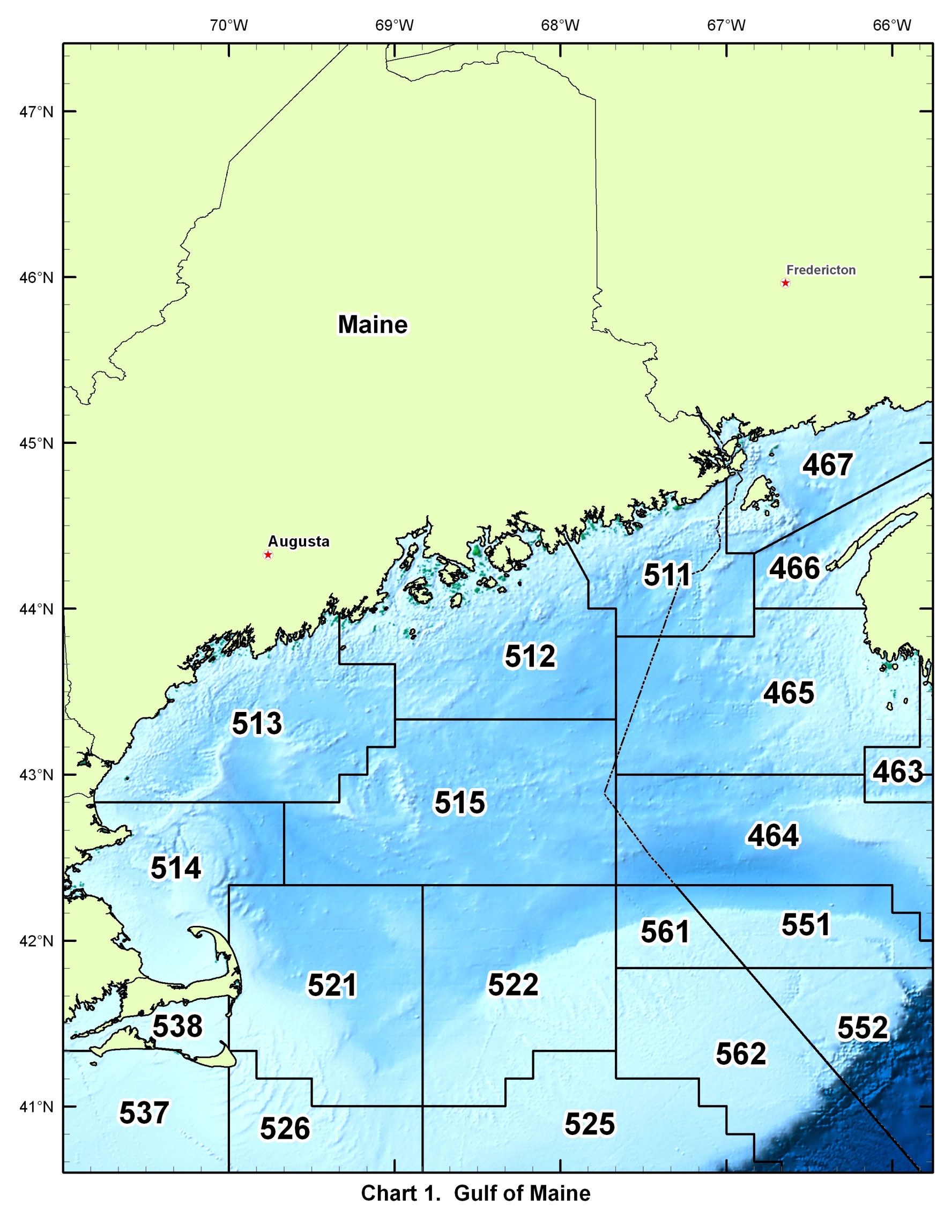

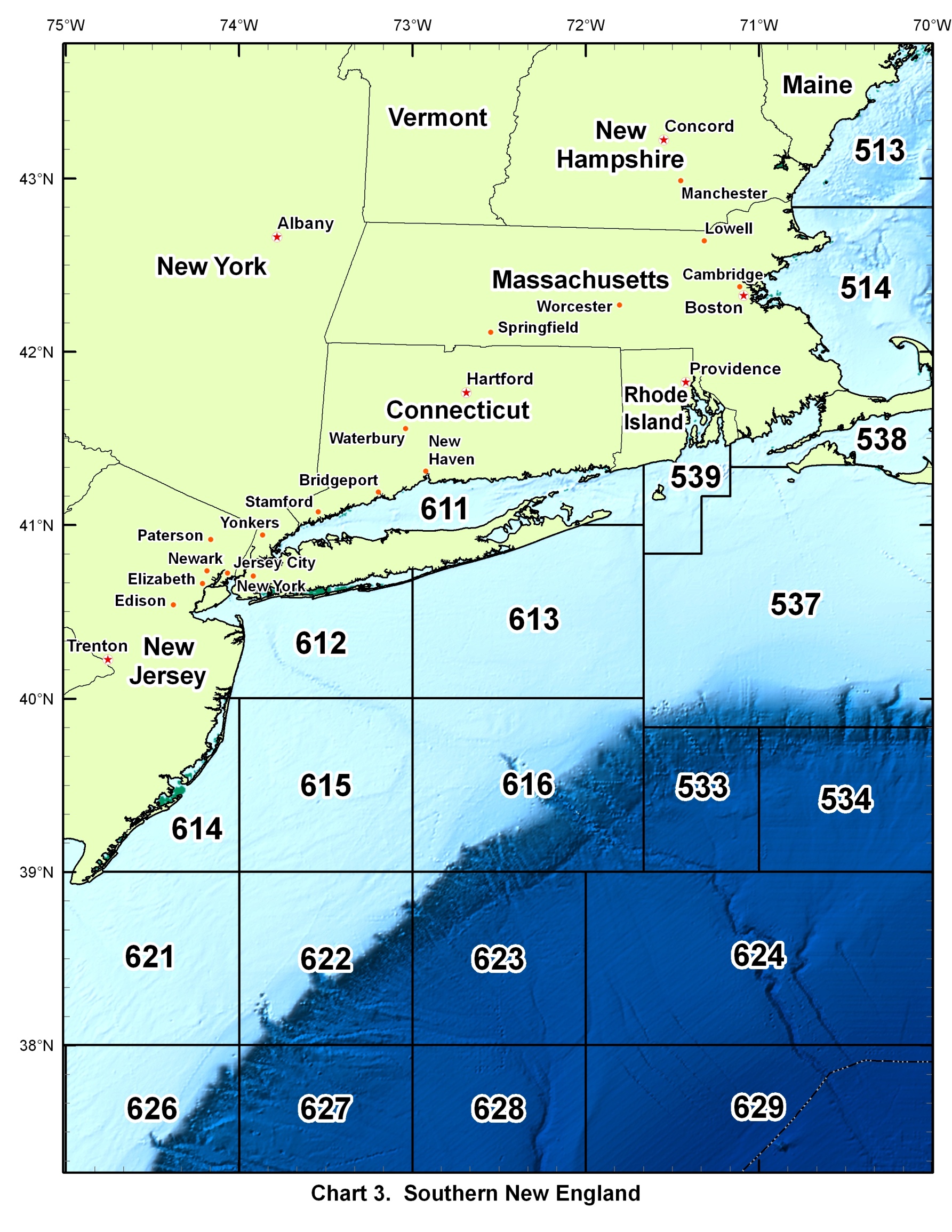
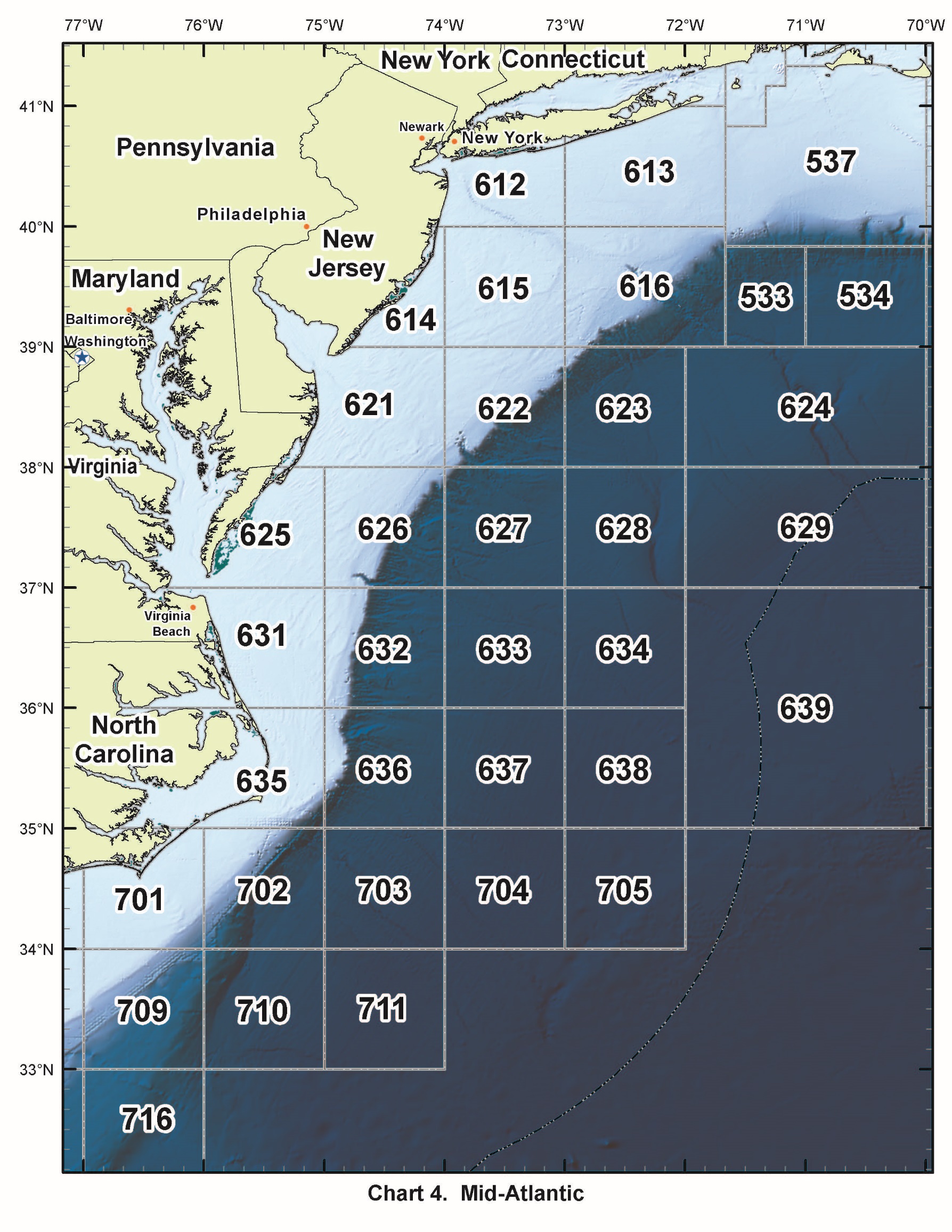
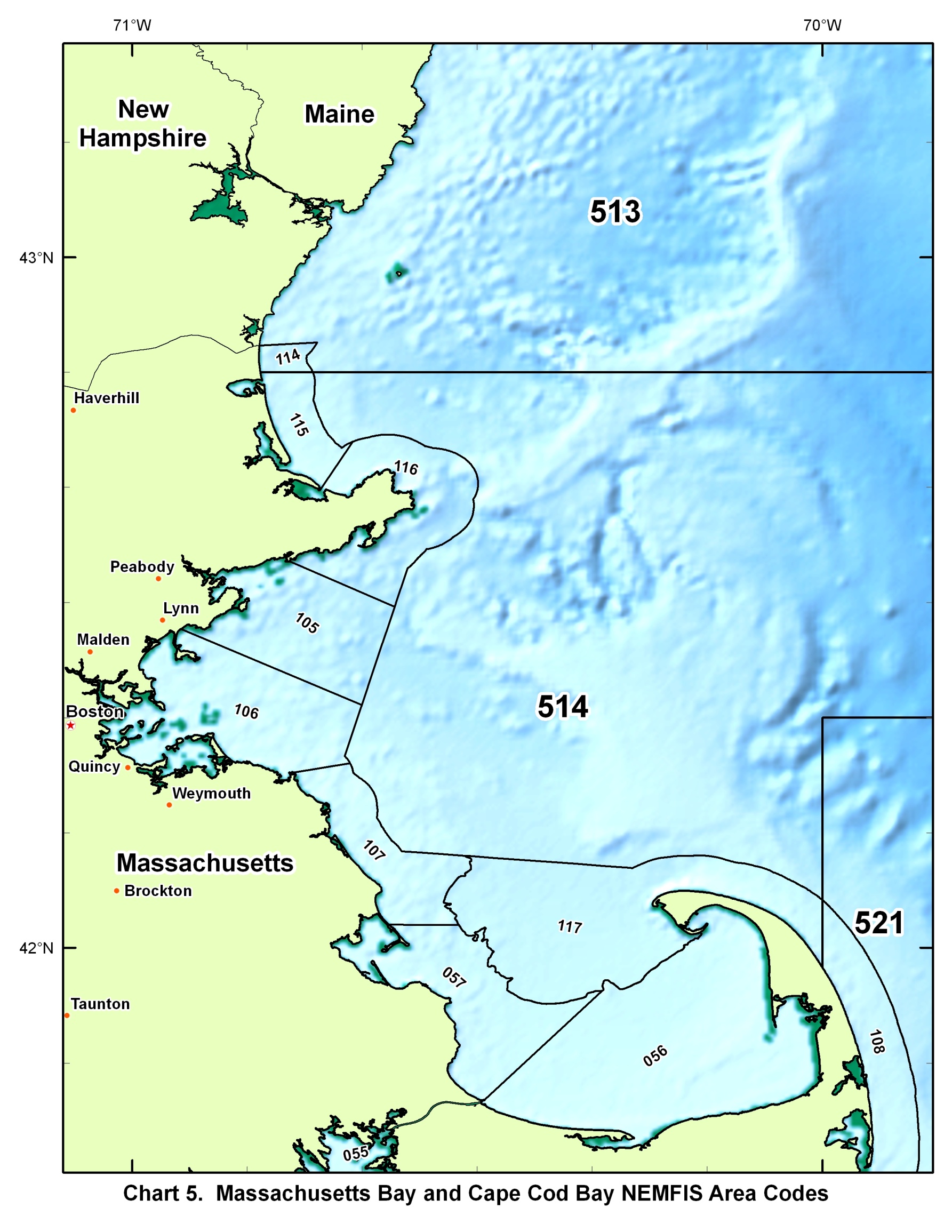
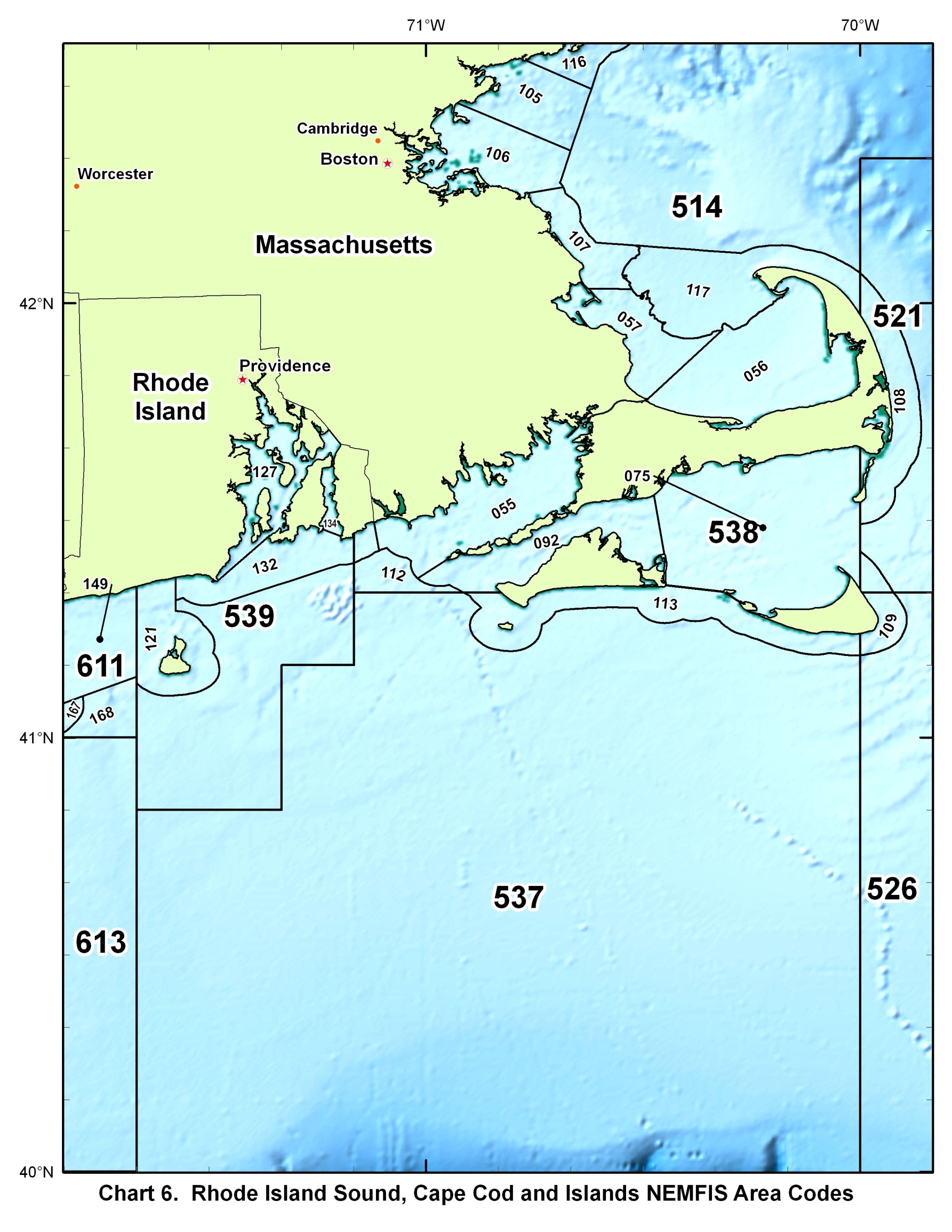
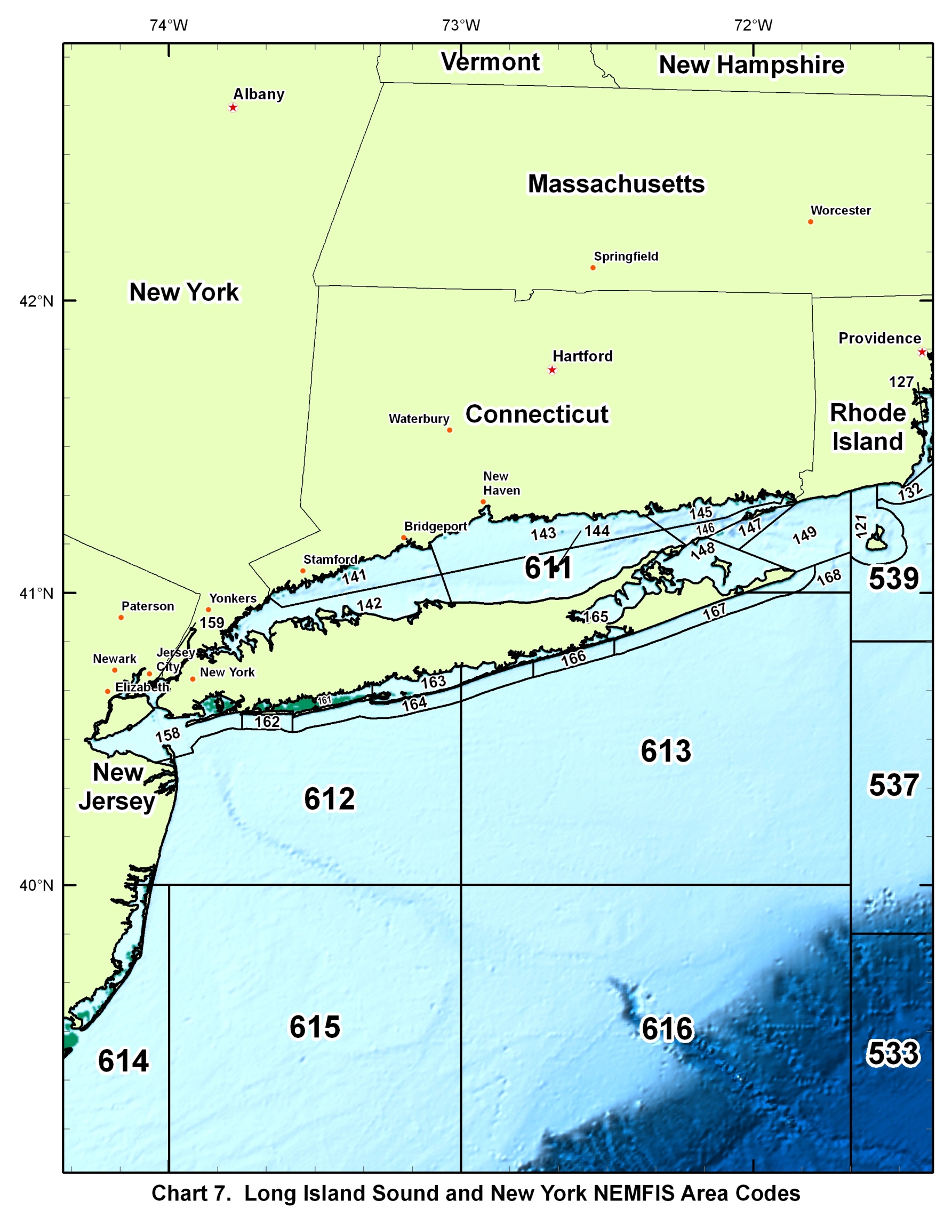
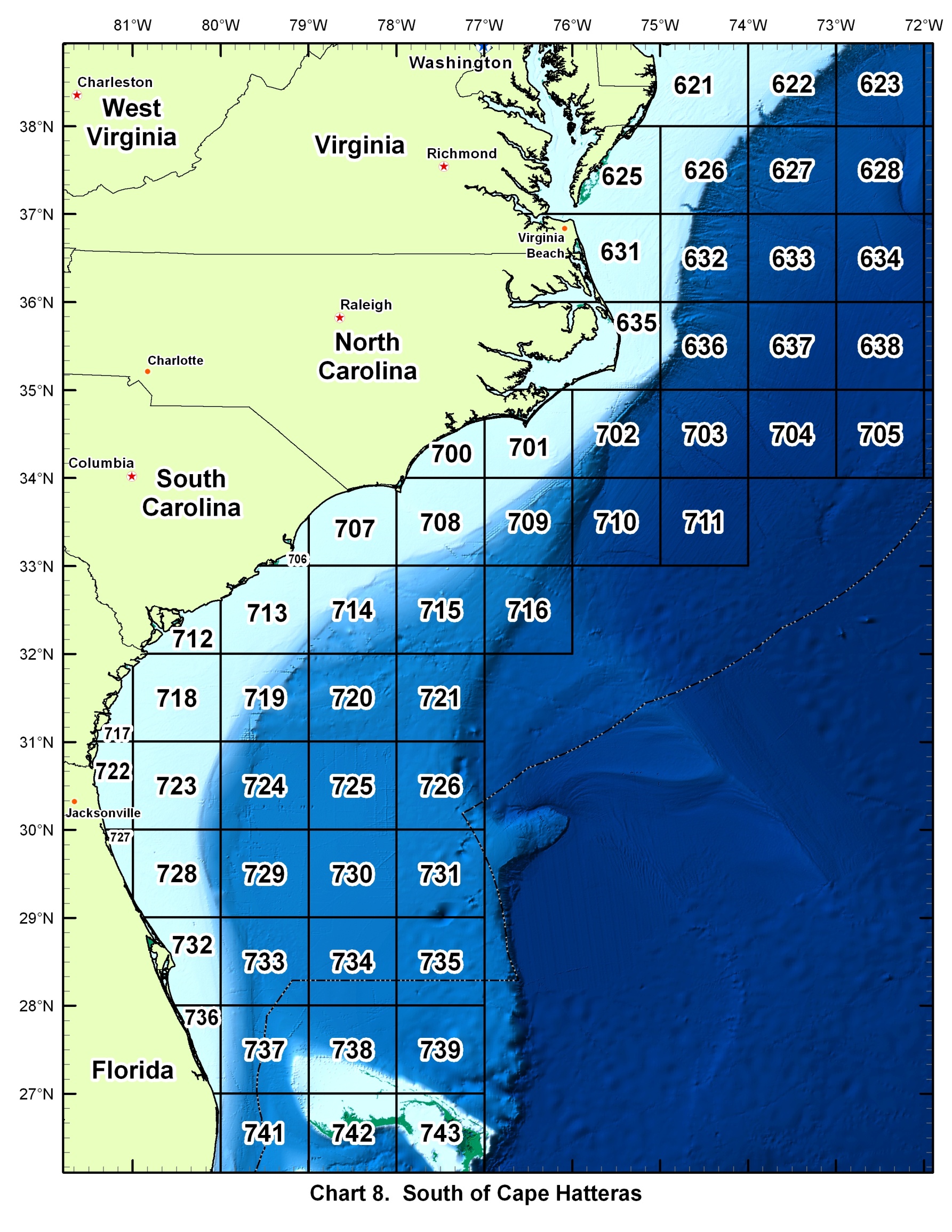
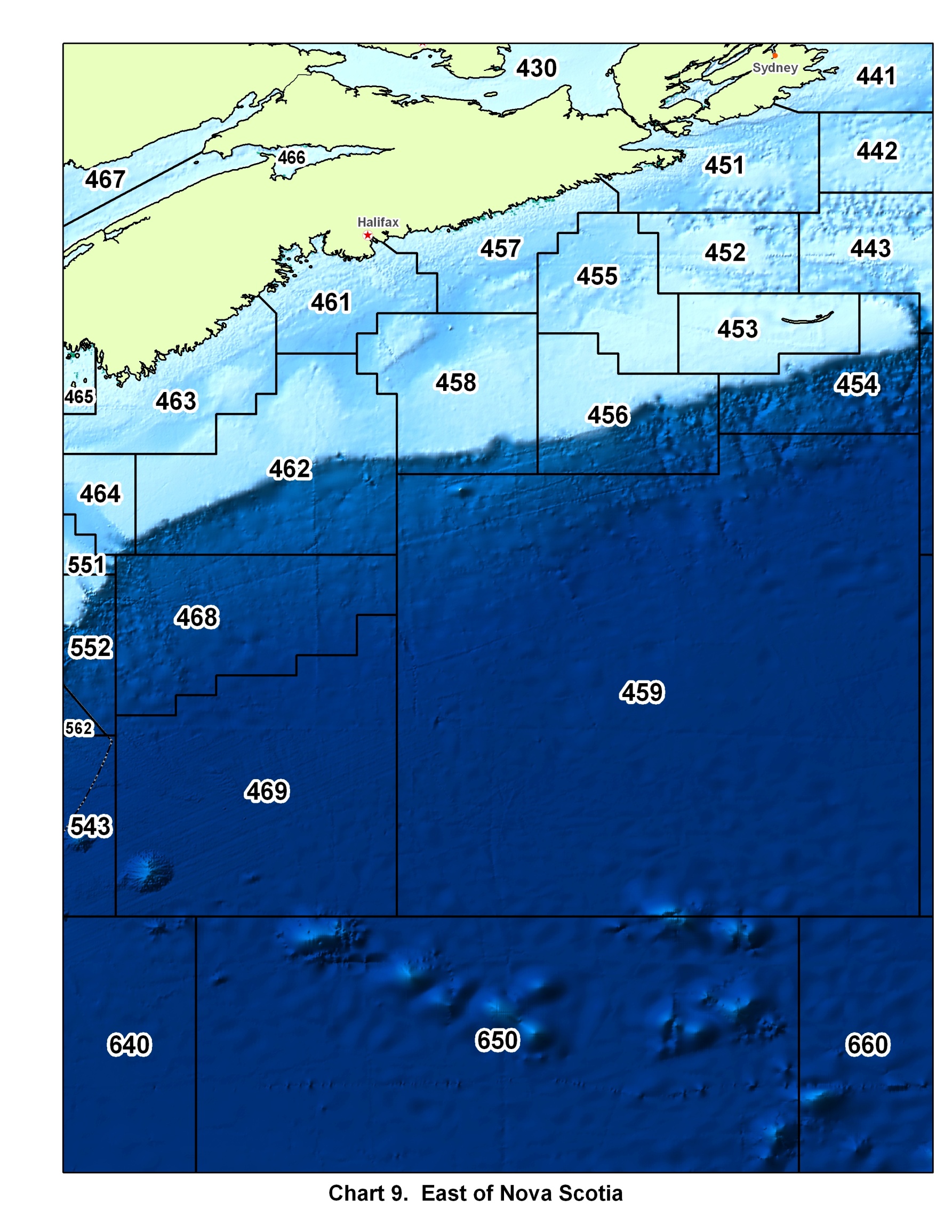
| File Type | application/vnd.openxmlformats-officedocument.wordprocessingml.document |
| File Title | AFISHING VESSEL TRIP REPORT@ REPORTING INSTRUCTIONS |
| Author | bclifford |
| File Modified | 0000-00-00 |
| File Created | 2021-03-10 |
© 2026 OMB.report | Privacy Policy